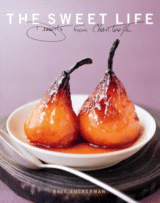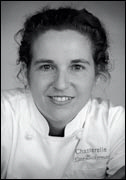On Writing The Sweet Life
by Kate Zuckerman
About two years ago, during the time when I was first contemplating writing The Sweet Life, I was in the process of rolling pâté sucrée, sweet tart dough, on a stainless steel worktable while simultaneously trying to explain to a pastry intern at Chanterelle how to whip egg whites for a batch of Goat Cheese and Basil Soufflés. Standing right next to her, but admittedly with my attention somewhat divided, I was walking her through the process of whipping egg whites, as she looked into the mixer's bowl, cream of tartar in one hand, sugar in the other. What I wanted her to produce was a shiny, voluminous, smooth meringue with stiff peaks. To get them to that stage you need to add acid and sugar at specific moments. I thought I'd be able to explain to her, without peeking into the bowl, what to look for: how to know when to add the cream of tartar, when to add the numerous teaspoons of sugar, at what speed to whip the eggs, and, most importantly, when to stop.

|
This experience stayed with me when I set out to write The Sweet Life. If I wasn't able to verbally explain the steps needed to whip up egg whites, how would I manage to instruct a reader whose bowl I certainly wouldn't be able to look into?
I recognized that, when I whip a bowl of egg whites, I'm looking for subtle visual and sensual clues that key me into coaxing a meringue to take shape with maximum volume, a lustrous shine, a homogenous texture, and a stiff mountain of peaks. But these clues are not explicit; they're experiential and ephemeral, and almost impossible to write down without a broader context. That context, I realized, was what is actually happening to the egg white proteins on a chemical level. If I could better understand why egg whites whip - and why acid and sugar and the right agitating tool used at the right speed are needed - maybe I could really teach a far away reader how to do it without needing to check on her results.
So, I began studying some of the chemistry of the pastry kitchen. I had a lot of help, from classic books like Harold McGee's On Food and Cooking and Shirley Corriher's CookWise, as well as from Kirsten Hubbard, a culinary student of mine who turned out to be a physicist with a burgeoning interest in food science. It was in the process of writing this all down, making it explicit and clear in decent English, that I really came to understand what has always been happening in my stainless steel bowls when I'm whipping egg whites.
Writing this book has made me an immeasurably better pastry chef: it's aroused so much curiosity and desire to explicate the experiences I have in the pastry kitchen. Really, it's the people who'll cook from my book that I have to thank for this, and I hope that by reading The Sweet Life they'll sense me standing next to them, looking into their bowls, watching for the clues that hopefully are no longer so mysterious.
 Kate Zuckerman, the
Pastry Chef at Chanterelle since 1999, is guided by an overriding belief
in the centrality of simple, pure, complementary flavors.
In 2005, Zuckerman was named one of the ten best pastry chefs in America
by Pastry Art & Design and Chocolatier magazines. Zuckerman's desserts,
which were described by The New York Times as a "life-changing experience,"
have earned her extravagant praise from every major critic in the New York area.
She has just published her debut cookbook, The Sweet Life: Desserts from Chanterelle,
with Bullfinch Press, a division of Little, Brown.
Kate Zuckerman, the
Pastry Chef at Chanterelle since 1999, is guided by an overriding belief
in the centrality of simple, pure, complementary flavors.
In 2005, Zuckerman was named one of the ten best pastry chefs in America
by Pastry Art & Design and Chocolatier magazines. Zuckerman's desserts,
which were described by The New York Times as a "life-changing experience,"
have earned her extravagant praise from every major critic in the New York area.
She has just published her debut cookbook, The Sweet Life: Desserts from Chanterelle,
with Bullfinch Press, a division of Little, Brown.
Return to the December 2006 issue of The IWJ.
